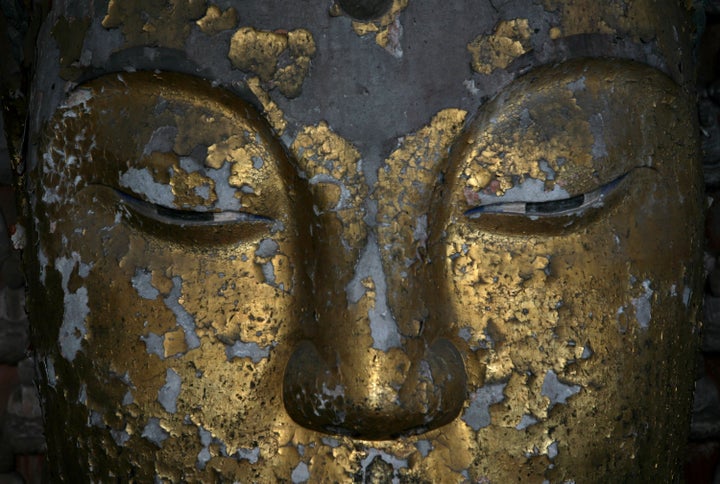
1. "Let It Ache" by Heather Maloney from her 2009 debut album Cozy Razor's Edge. (Listen here.)
This is a terrific song released by an independent musician who has a developed sound and recognizable style. Ms. Maloney has said she wrote the song during a weeklong silent retreat while mulling over an aching heart. Heartache is awful no matter where you are, but on a silent retreat a really interesting (to you), justified (to you), and powerful (to most any mind in training) internal dialog can consume the meditation hours. Ms. Maloney's lyrics cut to the chase of the matter: "If your heart is aching, let it ache. Let it weight, let it throb, let it break." Fine, yes, absolutely! we might say, but here's the thing: if I had only done or said this or that and so forth, I wouldn't have to even deal with these feelings and then, without these feelings, I'd be fine! Ms. Maloney's song, in bluesy form, reminds us of that uncomfortable first Noble Truth. In paraphrase, that there is suffering, that we will experience it and even much of what we currently experience as something akin to happiness, is actually causing us suffering.
I myself once spent a solitary retreat in utter mourning over an ending relationship and not only did I cry my eyes dry, but approximately zero Buddhist practice was accomplished! Sometimes the depths of our sorrow overshadow our meditative training and at moments like these I think well-written dharma music can be soothing. Hopefully musically catchy enough to drag our attention away from our pain for a bit, and lyrically genuine enough to remind us "If your heart is aching, let it ache. Let it tell you how it is to be a human heart ... "
2. "Matters How You Pray" by Eva Mohn on the 2010 compilation album Dhamma Gita: Music of Young Practitioners Inspired by the Dhamma.
I know almost nothing about Ms. Mohn, except that she is a musician and dancer living in Germany and I really like her song! It begins with the unmistakable sound of a metronome, which for me, trained as a classical musician, always evokes an almost Foucauldian resonance of discipline and punishment. In some ways this is what Ms. Mohn is singing about: that your actions have results and to her there appears to be a right way of living. "I sure as hell would like to do everything right and never pay the price in the next life" she sings. In this song what matters is paying attention; how something is done indicates one's internal state. This is of course not necessarily a 'Buddhist' insight; Ritual Studies has long grappled with the dichotomy between the ritual being performed correctly and the unknowable state of mind of the ritual specialist. Ms. Mohn takes a straightforward position on this matter and closes her chorus with the lines, "It matters how you wait / it matters how you take / it matters how you stay awake ... " The choice of the word "matter" here indicates both a Mahayana viewpoint and confidence in Buddhadharma, because if it didn't matter (maybe not to you, now, but at some point, to some being), why practice paying attention at all?
What is interesting to me musically about the song is the homey recording sound (you can hear the room's white noise picked up by the microphone throughout), the fun light percussive sounds and how the tinkly piano mimics Ms. Mohn's phrasing as it tails off or gains steam. It's like a quick snapshot into someone else's most salient dharmic understanding: be yourself, but be aware that how you act matters.
3. "Ki Ki So So" by Ravenna Michalsen from her 2007 album Dharmasong.
This is my song. It is perhaps more dreamy than my other work, but absolutely representative of my idea to bring non-exoticized sounds (i.e. the soundscape of American music), to what I wanted to express lyrically: my Buddhist experience. "Ki Ki So So" is part of a larger chant done within the Shambhala community to generate windhorse (Tib.: rlung rta), something akin to confidence without aggression or the spontaneous shifting of tight, fixed allegiance to something more spacious. I was trying to explain this song to a medical resident with whom I was out on a very uncomfortable second date; it was an ironic conversation to be having because he had introduced himself to me as a doctor, only afterwards giving his name. I tried to point out to him how his confidence seemed to be based on his identity as a doctor rather than who he was as a person. He said he felt insulted and walked out leaving me feeling like a terrible communicator and even worse Buddhist. Which is sort of the point of this song. I have a lot of devotion to my teacher, Sakyong Mipham Rinpoche, but, without fail, every time I am around him I feel as if I make a fool out of myself or I get angry that I have put him on a pedestal, or that everyone else around me has. Whatever the feeling, it's strong. 'Ki Ki So So' begins with eleven repetitions of the entire windhorse chant in five-part vocal layering, gearing me up to call my teacher's name against a backdrop of thunder and fading away to a quiet, almost melancholy mid-section. "I ride on your wind" is repeated in a round-like formation while I sing my biggest fear and truest behavior: "I didn't listen / to what you had to say / I will try".
American Buddhist music has not had any breakout stars or even viral songs within the various communities. But in the coming weeks I hope to introduce readers to more artists and songs that are musically accomplished and lyrically devoted to the dharma. Stay tuned!